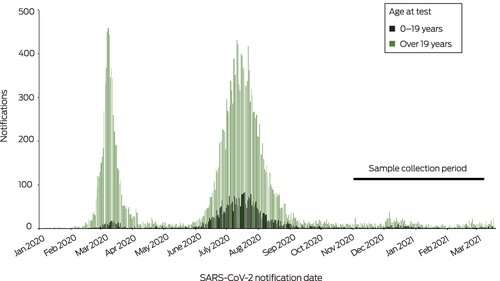At least one in 500 children estimated to have caught COVID-19 in pandemic’s first year

The seroprevalence of SARS-CoV-2-specific antibodies in children was between 0.21% and 0.42% early in 2021, according to research published today by the Medical Journal of Australia.
The “seroprevalence” of a sample of people is the proportion of people tested who had detectable antibodies against SARS-CoV-2 in their blood serum. This is important because it provides a way of estimating the fraction of a population that has been infected with the virus.
In Australia, the other way of doing this is relying on RAT or PCR testing during an active infection, but this undercounts infections because not everyone who is infected will do a test or report the result, especially as many infections are mild or asymptomatic.
To get a better estimate of how many people have been infected with the virus, epidemiologists look for sources of blood samples that are broadly representative of the population of interest. In the past this has been done using blood bank donations or blood samples obtained for routine clinical care.
The MJA study, led by Dr. Archana Koirala, a pediatric infectious diseases physician at the National Center for Immunization Research and Surveillance (NCIRS), and Nepean Hospital, used blood collected during anesthesia when children were having elective surgery. The researchers measured the seroprevalence in their sample of children, then extrapolated this to the broader population of Australian children.
“SARS-CoV-2-specific antibodies were detected in seven children (5–9 years, one; 10–19 years, six): three in Victoria, three in New South Wales, one in Queensland; three specimens were also positive in immunofluorescent antibody and microneutralization assays,” Koirala and colleagues reported.
“The crude seroprevalence of SARS-CoV-2-specific antibodies was 0.42%. After adjusting for sensitivity and specificity, estimated seroprevalence using the base case prior distribution for people aged 0–19 years was 0.23%.
“This corresponds to 13,719 aged 0–19 years in the five mainland states being infected with SARS-CoV-by early 2021. Using a less conservative prior distribution (greater weight assigned to lower seroprevalence values), estimated seroprevalence was 0.16%, corresponding to 9,545 infections.”
Apart from the estimate of seroprevalence, Koirala and colleagues also showed the approach of using blood samples taken while children were under anesthesia for elective surgery was useful and could be used for tracking the COVID-19 pandemic in the future.
Source: Read Full Article


